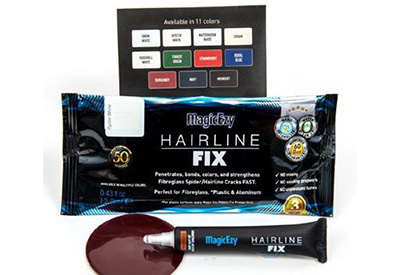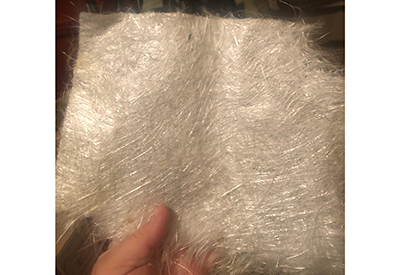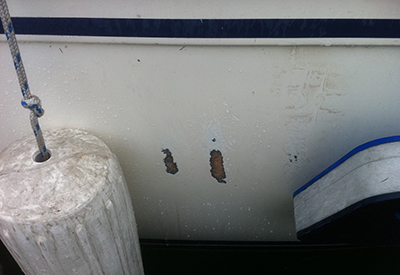Ask Andrew: Part 3 of Fibreglass repair – Epoxy

Apr 9, 2020
wetting out fibreglass using unthickened epoxy and a squeegee
In Parts 1 and 2 we discussed fiberglass and gelcoat. This time, we’ll explore the ways that epoxy can be used aboard.
In most marine chandleries, a section of shelving is often dedicated to paints, sealants and epoxies. Brand names like West System, System Three, MAS, East System (and others). In my opinion, personal preference and price are the determining factors between the brands – though, I recommend using all the products from one line in each application, because they are formulated specifically to be used together.
Each line or brand will have similar products available (West System popularized a numbering system which can be very convenient to ensure that the right product is used for the right application):
Epoxy Resin – This is the base that other products are added to, in order to achieve the desired results. Epoxy resins tend to be thicker than polyester resins, and are more versatile in a number of ways
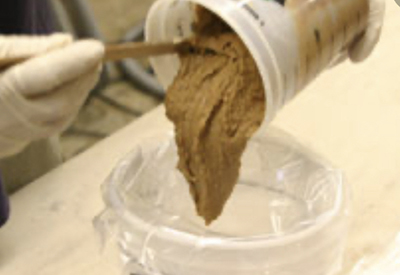 epoxy with thickening agents to make it peanut-butter consistency
epoxy with thickening agents to make it peanut-butter consistency
Hardener – this is mixed with the resin at a pre-determined ratio. In the early days of epoxy usage, resin and hardener volume had to be weighed or metered out. Today, manufacturers make is much more simple by producing metered pumps that fit into the product containers. The ratio of resin to hardener may be 2:1 (meaning that twice as much resin is used as hardener), but by using a metered pump (almost like a hand-soap dispenser), the user simply has to mix the same number of ‘pumps’ together. Therefore, 1 pump of Resin is mixed with 1 pump of hardener.
Hardeners are available in a standard, and also in ‘slow’ and ‘fast’ formulations. They work by initiating a chemical reaction with the resin. The reaction starts the moment that the two are mixed, so mixing and applying quickly can become important. Slowing down the reaction can be done by choosing a ‘slow’ hardener, and also keeping the mixing pot and work area cool and mixed thoroughly. Keeping warm hands away from the mixing pot, and giving the mixture a stir regularly helps. Similarly, ambient temperatures, as well as using a heat gun can speed up the reaction significantly.
Polyester resins and gelcoats are dependent on the quantity of MEKP hardener added (to a certain point), and can take 10+ hours (sometimes days) to fully cure. Epoxy mixtures shouldn’t be adjusted – the ratio needs to be kept to manufacturer specifications – but the type of hardener used and control of temperature can adjust the working time of the mixed epoxy.
With resin and hardener mixed, the workings for epoxy are present, but further products should be added based on the application that the epoxy is being prepared for.
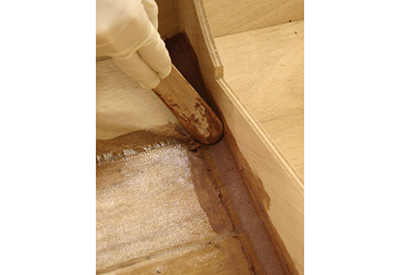 thickened epoxy brings formed into a fillet to strengthen the joint
thickened epoxy brings formed into a fillet to strengthen the joint
Epoxy can be used for a number of applications aboard:
Laying up Fibreglass – Epoxy can be used the same way that polyester resins can to infuse fiberglass cloth, roving and/or mat to fiberglass hulls, decks or components
Bonding/Adhesive – by adding a strengthening filler, epoxy can be used to bond objects, including: scarf joints in wood, laminating wooden parts into curved shapes, adhering wood or fiberglass eliminating the need for hardware.
Strengthening – epoxy can be thickened with strengthening fillers and spread along joint edges in a fillet, increasing the overall strength of the joint.
Filling/Fairing – a filling/fairing compound can be added to epoxy making it a peanut butter consistency, allowing it to be troweled into gaps, holes or damaged sections. Once cured, the fairing compound becomes easy to sand and smooth.
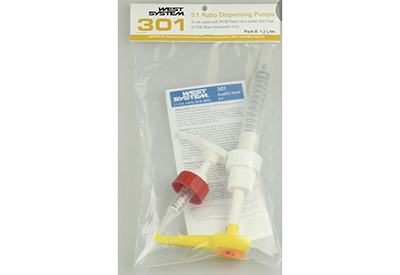 Sealing/coating – epoxy (with no fillers) can be painted or rolled over surfaces (particularly bare wood or end grain) to protect areas from rot or damage. The results can be an attractive glossy finish.
Sealing/coating – epoxy (with no fillers) can be painted or rolled over surfaces (particularly bare wood or end grain) to protect areas from rot or damage. The results can be an attractive glossy finish.
Casting – epoxy can be poured into a mould, or infused into carbon fibre or Kevlar to make composite shapes and components. Epoxy maintains it’s volume as it cures, as opposed to polyester resins which shrink as they cure (polyester resins will often crack when poured into a mould).
metering pumps that allow the correct ratio of resin to hardener
There are a variety of pros and cons to epoxy – here are the most notable, when taken from a boat owner’s perspective:
Pros: Cons:
• Ease of use – Can irritate skin and fumes are toxic
• Preformulated adhesives and fillers – Short working time
• High availability – High cost
• Adheres to most boat components – Doesn’t adhere to plastic
• Established brands with customer support – polyester resins don’t adhere to epoxies
• High degree of strength and durability – gives off heat when curing
• Numerous applications aboard
If you’re planning to make a first attempt with the use of resins or fiberglass, I would highly recommend using epoxy to start, as opposed to polyester resins – they’re quite forgiving, and manufacturers have the end-user in mind in the formulations, packaging and educational literature. There are many books available, along with manufacturers websites and video tutorials. Enjoy the journey!
 Andrew McDonald is the owner of Lakeside Marine Services – a boat repair/maintenance firm based in Toronto. Andrew has worked in the marine industry for 12 years and is a graduate of the Georgian College ‘Mechanical Techniques – Marine Engine Mechanic’ program.
Andrew McDonald is the owner of Lakeside Marine Services – a boat repair/maintenance firm based in Toronto. Andrew has worked in the marine industry for 12 years and is a graduate of the Georgian College ‘Mechanical Techniques – Marine Engine Mechanic’ program.
Questions or comments for Andrew? Email him directly via: askandrew@lakesidemarineservices.ca



